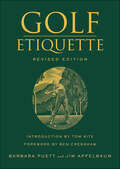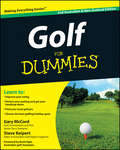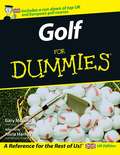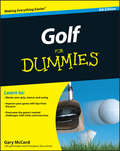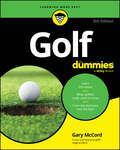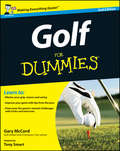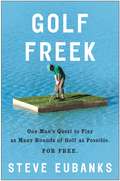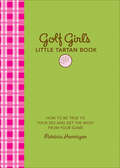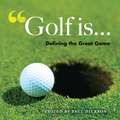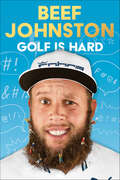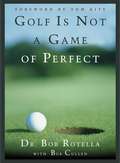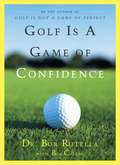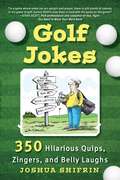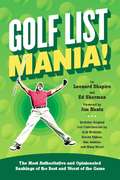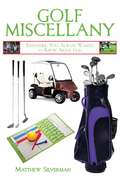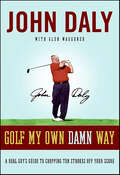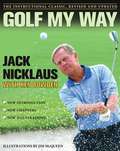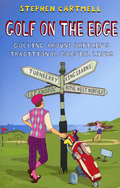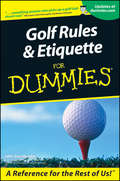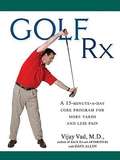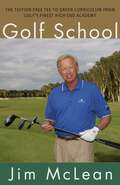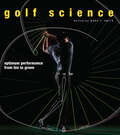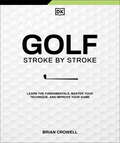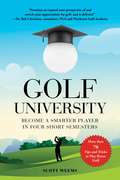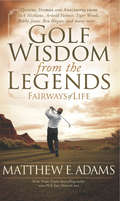- Table View
- List View
Golf Etiquette
by Jim Apfelbaum Barbara PuettA revised, more focused edition of the essential golf etiquette handbook.Filled with pictures, detailed diagrams and extensive definitions, this revised edition from Barbara Puett and Jim Apfelbaumis all a golfer will ever need to learn proper etiquette on the golf course.Tiger Wood's popularity has introduced golf to thousands. Very few, however know proper golf etiquette--which is essential to enjoying the game. The revised edition of the classic book is vital for amateur and experienced players in addressing golf's number one problem: slow play. The book Paul Harvey lauded as "The first and last word on how properly to behave on and off the golf course covers:*Proper attire*Playing through*Playing with Strangers*And much moreAll the latest advances are taken into account: satellite-based yardage systems, alternative spikes, and cell phones. Its handy size and useful photos and diagram make Golf Etiquette the perfect guide for on-the-fly tips and rules.
Golf For Dummies
by Steve Keipert Gary McCordAn informative and entertaining guide to the world of golf Want to get your handicap down or just get out of a bunker? Golf For Dummies, 2nd Australian and New Zealand edition, is the complete reference for golfers of all experience levels. Get some great advice on improving your technique with step-by-step instructions and photographs. Pick up the right equipment, hit the green and have fun along the way! Challenge yourself to play better — get tips on taking your game to the next level Get out of trouble — know your options when facing difficult recovery shots Understand the handicap system — discover how to get a handicap, how it's calculated and what it means Work on your technique — develop strategies to improve your swing Focus on your golf fitness — learn ways to get into golf shape Choose where to play — find out where to practise and play golf Watch golf in person — discover where you can watch live golf and interact with players Learn more about the greats of the game — find out who made Brett Ogle's top ten Open the book and find: Advice on choosing the correct equipment Chipping, pitching and putting tips Instructions for getting out of bunkers Rules, etiquette and how to keep score Methods for overcoming the 'yips' and 'shanks' How to fit in at the golf club Learn to: Improve your swing Perfect your putting and get your handicap down Find your local golf pro Choose the best golfing holiday spots
Golf For Dummies
by Gary McCordDiscover how to take strokes off your game by improving the technique of your swing with step-by-step photos and master the all- important putt to better your score. Whether you’re new to golf or a long-time duffer, this easy-to-follow guide will get you into the swing of things by helping you to: Master grip, stance, and swing Fix common faults Improve your putting Know the score on rules and etiquette Take advantage of high-tech equipment Shape up with golf-specific exercises Where to play in the UK and Europe How to choose your golf balls and clubs Getting and staying in golf shape Getting the most from your lessons Developing your own swing Putting, chipping, and pitching Special shots, conditions, and considerations
Golf For Dummies
by Gary McCordThe fun and easy way to get a grip on golf Golf For Dummies, 4th Edition, gives you all the latest information on the game, including updated expert advice on everything from improving fundamentals to mastering the game's mental aspects. With advice from professional Gary McCord, this expert guide gives you easy to follow instructions for hitting the ball farther and straighter, and hints on how to shave strokes off your game. Updated instructions on grips, stances, and swings The most current stars and best courses New tips from top players on how to improve your game Details on the latest golf equipment and technology Playing golf is fun-playing better is even more fun. With a little help from Golf For Dummies, 4th Edition, you'll have the time of your life whenever you hit the links.
Golf For Dummies
by Gary McCordLevel up your own golf game, or enjoy the sport as a spectator Golf is a great sport for all types of people. It's a low impact form of exercise, a social activity, and it gets you outdoors. Golf For Dummies teaches you the rules of the game and gives you tips on improving your play. If you're more of a spectator, you'll love this book's coverage of the latest golf trends and the best players on the pro courses. Helpful illustrations make it easy to understand how golf really works, so you can step onto the green with confidence. In this new edition, you can learn all about new golf formats and recent changes to the rulebook. Ready to play a round? Understand golf basics, perfect your swing, and master the mental game Follow simple instructions and diagrams to improve your grips and stances Learn how the sport of golf is changing, at the amateur and professional levels Improve your golf game with advice from a championship-winning golfer This is a great Dummies guide for anyone looking for a general introduction to the sport, as well as current players who want to take their game to the next level. Have fun when you hit the links!
Golf For Dummies
by Mccord Tony SmartThe fun and easy way to get into the swing of things and take strokes off your game - fast Whether you're a total beginner or you've clocked a few hours on the links, Golf For Dummies, 2nd Edition is the only guide you need. Packed with expert tips and techniques for everything from mastering your grip, stance and swing to shaping up with golf-specific exercises, this updated and expanded edition of the international bestseller features new, step-by-step photos, tips for women players, seniors and lefties, and loads of fun golf history facts. Learn your ABCs - master the basics, from golf lingo and choosing your clubs, to who to play with and where Watch your step - get the lowdown on golf rules, how to keep score, and take a crash-course on gamesmanship and the do's and taboos of golf-course etiquette Get into the swing - delve into the art and science of the golf swing, including how to blast your way out of bunkers and how to develop an effective putting stroke Tackle the tough shots - finesse difficult shots like a pro and deal with bad weather and bad luck with grace and skill Fine-tune your play - zero in on common faults and bad habits and learn time-tested techniques for easily fixing them once and for all To school or not to school - decide whether formal lessons are right for you and find out how to select a great teacher'If you've ever wanted to know more about golf or improve your game then this is your guide' - The Fairway, from a review of the 1st edition'Does exactly what it says on the tin!' - Today's Golfer, from a review of the 1st editionOpen the book and find: Tips on choosing golf balls and clubs Exercises for getting and staying in golf shape How to develop your own swing Putting, chipping and pitching Mastering grip, stance and swing Simple fixes for common faults Golf rules and etiquette Advice on taking advantage of high-tech equipment Where to play in the UK and EuropeLearn to: Master your grip, stance and swing Improve your game with tips from the pros Overcome the game's mental challenges with tricks and exercises
Golf Freek: One Man's Quest to Play as Many Rounds of Golf as Possible. For Free.
by Steve EubanksSteve Eubanks lives on a golf course, spends most of his time with a golf club in his hand, and simply cannot pass a course without playing it. In Golf Freek, he chronicles his travels around the globe for the sole purpose of playing as much free golf--the operative word being free--in as many interesting places and with as many interesting people as possible. As Steve himself says, "This book is not some mystic search to find my soul through a ball-and-stick metaphor. It's about me, the golf freek, sponging free golf. It's a mixture of On the Road (without the booze, hookers, guns, and poverty) and Rick Reilly's Who's Your Caddy? (with John Daly keeping his private parts to himself)."Along the way he tells some of the world's greatest golf stories--funny, touching, bizarre, and sometimes personal--from his rounds with Arnold Palmer to his hole in one in the Chinese town where his daughter was born. These tales, taken together, add up to one of the most revealing books aboutFrom the Hardcover edition.
Golf Girl's Little Tartan Book: How to Be True to Your Sex and Get the Most from Your Game
by Patricia HanniganPlay like a girl! A female golf writer offers tips, inspiration, and laughs for women who want to excel at the sport. Golf blogger Patricia Hannigan has a driving ambition: to get each of her thousands of female followers to play like a girl. That, she insists, is just the way for a woman to excel at golf—and, every bit as important, to have a lot of fun doing so. A witty and wise departure from oh-so-predictable instructional guides, Golf Girl&’s Little Tartan Book doesn&’t focus only on technique. Hannigan also writes about attitude and the mental game, demonstrating how a gal who&’s passionate about golf can use her womanly style to her distinct advantage on the course. From teeing off (don&’t be coy about using those red tees) to getting teed off (don&’t be timid about throwing the occasional tantrum), Hannigan entertainingly dispenses advice that&’s sure to be useful to any woman intent on securing membership in the &“boys&’ club&” called golf.
Golf Is . . .: Defining the Great Game
by Paul DicksonThe unconquerable frustration of golf, in which every player competes largely against himself and almost always loses, brings out a rich vein of unquenchable wit and fatalistic humor. Enhanced by historical and modern photographs, this hole-in-one gift book collects quotations that complete the phrase "Golf is . . ." Incisive observations from duffers and pros alike include remarks by P. G. Wodehouse, G. K. Chesterton, Winston Churchill, Ben Hogan, Tommy Bolt, and many others.
Golf Is Hard
by Beef JohnstonOne of golf's most popular and funny personalities reveals the ups and downs of a life playing the world's most infuriating sport. Professional golfer Andrew "Beef" Johnston has played in the world's biggest tournament, won big-money events, and sunk monster putts while fans were booming out his nickname: "BEEEEEEF!" On the downside, Beef has also duffed it, thinned it, and shanked it like every single person who's ever played the game. Because no matter who you are, golf can make you look like an idiot.Golf is Hard reflects on Beef's early years at his local Pitch & Putt to his stellar career playing against the best on the greatest courses on the planet, taking you inside the world of professional golf like no book before. With painfully honest stories, Beef delves into the pressure of the profession, but also shares golfing advice and side-splitting behind-the-scenes insights to bring a new perspective to the game. What is Tiger Woods really like in the locker room? How did it feel to hit one of the worst shots in golf history in front of millions of viewers during The British Open? And just how many clubs has Beef broken through fits of rage and frustration during his illustrious career?This is a book for everyone who has ever loved and loathed the game in equal measure but managed to see the funny side. After all, golf is really hard, so you might as well have a laugh about it along the way.
Golf Is Not a Game of Perfect: 365 Anecdotes And Lessons By Today's Leading Golf Guru
by Bob RotellaDr. Bob Rotella is one of the hottest performance consultants in America today. Among his many professional clients are Nick Price (last year's Player of the Year), Tom Kite, Davis Love III, Pat Bradley, Brad Faxon, John Daly, and many others. Rotella, or "Doc," as most players refer to him, goes beyond just the usual mental aspects of the game and the reliance on specific techniques. What Rotella does here in this extraordinary book, and with his clients, is to create an attitude and a mindset about all aspects of a golfer's game, from mental preparation to competition. The most wonderful aspect of it all is that it is done in a conversational fashion, in a dynamic blend of anecdote and lesson. And, as some of the world's greatest golfers will attest, the results are spectacular. Golfers will improve their golf game and have more fun playing. Some of Rotella's maxims include: * On the first tee, a golfer must expect only two things of himself: to have fun, and to focus his mind properly on every shot. * Golfers must learn to love 'the challenge when they hit a ball into the rough, trees, or sand. The alternatives -- anger, fear, whining, and cheating -- do no good. * Confidence is crucial to good golf. Confidence is simply the aggregate of the thoughts you have about yourself. * It is more important to be decisive than to be correct when preparing to play any golf shot or putt. Filled with delightful and insightful stories about golf and the golfers Rotella works with, Golf Is Not a Game of Perfect will improve the game of even the most casual weekend player.
Golf Is a Game of Confidence
by Bob Cullen Dr. Bob RotellaFrom the author of the bestselling Golf is Not a Game of Perfect comes a masterly illumination of golf's mental game.When that book was published, Dr Bob Rotella made accessible for the first time what he had learned from working with the best golfers in the world. Dr Rotella follows up the success of Golf is Not a Game of Perfect with a book filled with anecdotes and motivational instruction focusing on the most important skill a golfer can have: the ability to think confidently. Filled with inspirational stories about the great players, great courses and great tournaments, Golf Is a Game of Confidence encourages golfers, no matter what their level, to reach new heights in their games and their lives.
Golf Jokes: 350 Hilarious Quips, Zingers, and Belly Laughs
by Joshua ShifrinIn Golf Jokes, Josh Shifrin has put together a list of the funniest, most humorous, side-stitching, belly busting, and toe-tickling list of comedic prose to keep you laughing throughout anything this amazing game can throw at you. From concise one-liners to fuller-length quips, Shifrin takes you from the fairway to the green and beyond. Some of the hundreds of jokes include: Why do true golfers always avoid pie whenever possible? Because they are worried that they might get a slice.Why are golf balls similar to eggs? Because they&’re white, normally sold by the dozen, and every week you need to buy more of them.How many golfers does it take to change a light bulb? Fore!What gives most golfers nightmares? The Bogeyman.Where can you find a golfer on most Saturday nights? Out clubbing, of course.Golf is very similar to paying your taxes. You strive for the green but eventually come out in the hole.And many more! The perfect gift for golf gurus everywhere!
Golf List Mania!: The Most Authoritative and Opinionated Rankings of the Best and Worst of the Game
by Ed Sherman Len ShapiroFrom Best Courses to Biggest Chokes, Most Underrated to Worst-Dressed Golfers, Golf List Mania includes 120 lists that will inform and entertain. Includes contributions by personalities including Jack Nicklaus, David Feherty, and more, plus a Foreword by Jim Nantz. aWhy you'll enjoy this book: 5. Contributions from famous golf writers. You'll get the perspective from some of the best in the business. 4. Lists from the greats, including golf's Big 3: Jack Nicklaus, Arnold Palmer and Gary Player. It doesn't get much better than that. 3. A walk through golf history from Young and Old Tom Morris to Tiger Woods. You'll learn a thing or two along the way. 2. There are no right answers. The fun part of this book is the debates that they spark. I'm sure there will be lists when you go, That guy is a complete idiot. Isn't that the essence of golf and sports? 1. The next best thing to playing golf is reading about golf. You also make fewer bogeys that way. My good friends, Ed and Len, have compiled more than 100 juicy and interesting lists that are sure to entertain. aI hope you enjoy this unique look at the game we all love. --From the Foreword
Golf Miscellany: Everything You Always Wanted to Know About Golf (Books of Miscellany)
by Matthew SilvermanWhat causes a golf ball to hook or slice? What are the origins of the terms "bogey" and "birdie"? Why was Jack Nicklaus called "The Golden Bear"? "Why is the Masters champion presented with a green jacket? How many tournaments did Byron Nelson win in 1945?With Golf Miscellany, the fascinating history and lore of golf are finally revealed! For example, the reason a golf ball hooks or slices is that its spin drags a layer of air across one surface of the ball faster than it does across the opposite surface. "Bogey" refers to a score of one over par on a golf hole, the term originating from a British song from the late nineteenth century. Jack Nicklaus was dubbed The Golden Bear by his former agent, Mark McCormick, because he was "large, strong, and blonde." Every Masters champion since 1949 has been presented with a green jacket, indicating their membership in the exclusive private club. And the great Byron Nelson won a whopping eighteen tournaments in 1945 including eleven in a row, both records which stand to this day.Packed with all manner of delightful surprises, beautiful illustrations and photos, and surprising nuggets of information, Golf Miscellany demystifies the origins and customs of one of the world's most celebrated game. From the driving range through the U.S. Open, you'll be entertained with fun, little-known facts. Why do golfers wear collared shirts? Who invented the modern putter? What golfer was famous for saying he dug his golf game out of the dirt? Settle into your favorite armchair, sip on an Arnold Palmer, and find out!
Golf My Own Damn Way: A Real Guy's Guide to Chopping Ten Strokes Off Your Score
by Glen Waggoner John DalyIf you know anything at all about John Daly—and if you don't, what in the hell are you doing with this book in your hands?—you know he approaches the game of golf from an, uh, slightly different perspective than your average two-time major winner. How different? Well, for starters, Long John thinks the PGA Tour ought to permit Bermuda shorts, make carts mandatory, let him wear his hair down to his butt if he wants to, and strip-search tournament patrons at the entrance gate to keep cameras and cell phones off the course.In Golf My Own Damn Way, you'll take a virtual ride on Big John's magic bus as he tells you the best way to grip it so you can rip it. Looking for a sure cure to bunkerphobia? It's here. A one-hour golf lesson that's 100 percent guaranteed to make you a better golfer? Ditto. Want to know why you should occasionally leave your big dog in your trunk, how to watch your weight, and what golf and sex have in common? You came to the right book. And while he's busy explaining all these and many other things, Daly also tells you why you should keep your head out of the game, let your belly lead your hands, listen to your right foot, check your ball position—and buy a hybrid (the club, not the car).Following in the spike prints of his 2006 bestselling autobiography, My Life In and Out of the Rough, Golf My Own Damn Way is an off-the-wall and intensely personal yet imminently practical and accessible tip sheet on how to cut ten strokes off your score—now. Two things are certain: you've never seen a golf instructional book quite like this one, and you'll never need another one. Fairways and greens, Pard!
Golf My Way: The Instructional Classic
by Jack NicklausHailed as a classic and read everywhere golf is played, Golf My Way has sold more than 2 million copies worldwide since it was first published in 1974.Finally, Jack Nicklaus, golf&’s leading master, definitively covers the whole of his game through a lifetime of greatness. Golf My Way presents an all-inclusive, A-to-Z explanation of how this greatest of champions thinks about and plays the game. This book includes: -New introduction, endpiece, and illustrations -Brand-new chapters discussing the changes in Nicklaus&’s outlook and techniques -Reflections on the differences in tournament golf today compared with when Nicklaus joined the PGA tour in 1962 -Advice on the mental elements of improved playing that are not directly related to ball-striking or shot-making
Golf On The Edge
by Stephen CartmellBecause of its island status, the British shoreline enjoys more traditional coastal golf courses than anywhere in world. When Stephen Cartmell set himself the challenge of finding and testing eighteen of the most outstanding links courses in Britain, he decided that they had to meet a number of important criteria - the most significant of which was that the sea had to be visible from the course and, preferably, should present a physical hazard to any wayward shots. Stephen Cartmell provides hilarious descriptions of these sea-flanked courses, not to mention the characters he meets on his journey around the British coastline in this perfect guide for those tempted to play Golf on the Edge.
Golf Rules and Etiquette For Dummies (For Dummies Ser.)
by John SteinbrederHow to stick to the rules -- and avoid the traps of the game Filled with tips and anecdotes from the pros plus the 34 rules of golf, this ideal companion to the top-selling Golf For Dummies, 2nd Edition includes: Expert advice on the do's and don'ts of golf etiquette -- from dress code to betting on the game Advice on how to survive a business golf outing -- plus tips on behavior as both a spectator and a player The inside scoop on proper etiquette, from replacing divots to using your cell phone
Golf Rx: A 15-Minute-a-Day Core Program for More Yards and Less Pain
by Dave Allen Vijay VadNow in paperback, the official physician to the PGA Tour shares his groundbreaking research on preventing back pain and adding more yards to your drives. It is estimated that half of all recreational golfers and one-third of all professional golfers suffer from some form of lower-back pain. Conventional wisdom suggests that the twisting nature of the golf swing is the sole culprit. But research conducted by sports-medicine specialist Vijay Vad, M.D., reveals that the swing is only one of several factors. Applying Dr. Vad?s winning combination of mind/body wisdom and medical expertise to the game of golf, Golf Rx shares his cutting-edge findings. Complete with more than one hundred photographs, Golf Rx is a practical guide that brings the wisdom of one of America?s leading sports-medicine authorities to golfers of any level or age.
Golf School: The Tuition-Free Tee-to-Green Curriculum from Golf's Finest High End Academy
by Jim McLeanStephen Henderson describes a fascinating series of culinary adventures, during which he spent time laboring alongside many gastrophilanthropists, or chefs who make feeding the needy their form of charity. Part memoir, and part how-to guide, Henderson&’s field reports from across the globe show how much joy a good meal will give to a homeless and hungry person.Get the benefits of Jim McLean's four golf school curriculums—the Full-Swing School, the Short-Game School, the Management School, and the Mental School—without the four-figure cost.Jim McLean is known as golf's complete teacher, and his golf schools (The Doral Resort/Miami, PGA West/Palm Springs, Grand Traverse/Michigan, Legend Trail Golf Club/Scottsdale, Royal Links/Las Vegas, Mariner's Point/San Francisco, Deer Creek/Toronto) have been rated the best in the country by U.S. News & World Report. Blending McLean's expert advice with over two hundred photographs detailing the syllabus of his exceptionally popular teaching facilities, Golf School is the must-have instructional for the tens of thousands of McLean's graduates and an irresistible and affordable golf bible for all those who dream of one day breaking eighty.Golf School is for every level of play. High handicappers and beginners can all benefit from McLean's detailed study of the fundamentals of golf--grip, stance, posture, aim, and alignment. Low handicappers will be drawn to the author's advice on the mental game, course management, and how to become a "player"—someone capable of firing rounds in the sixties. In addition to the basics and the more advanced elements of the game, McLean shares his secrets for attaining consistency on the links with pre- and post-round practice tips and homework assignments designed to complete between rounds.No other golf instructor has brought the golf school experience to the written page. For the first time, golfers will be able to attend a golf school tuition-free with one of the greatest living teachers from the comfort of their own backyards.
Golf Science: Optimum Performance from Tee to Green
by Mark F. SmithGolf is perhaps the most complicated simple game ever invented. Golfing greats like Jack Nicklaus and Tiger Woods make the sport look easy, but anyone who has ever picked up a club knows how truly frustrating golf can be. The success of each shot depends on a diverse range of factors, from the club you choose and the speed with which you swing it, to your mood, the weather, and even the type and cut of the grass. Science plays a crucial role in most, if not all, of these factors, and in Golf Science, sports science expert Mark F. Smith investigates the cutting-edge scientific wonders that take the ball from tee to hole. Each chapter explores a different facet of the game--mind and body, the swing, the equipment, the environment, coaching with technology, the practice process, and the score--and is organized around a series of questions. What happens in the brain during the preshot routine? Does head movement hinder swing performance? Will I hit the ball farther with a longer driver? Why do I lose distance into the wind? What can I learn from watching my ball in flight? How should practice be structured? What are the key stats in golf that I need to know? Each question is examined with the aid of explanatory diagrams and illustrations, and the book can be used to search for particular topics, or read straight through for a comprehensive overview of how golfer and equipment work together. A must-have for anyone who delights in the spirit of the game, Golf Science will be enjoyed not only by professionals and coaches but also by spectators of the PGA Tour and anyone who enjoys a round of eighteen holes on the weekend.
Golf Stroke by Stroke: Learn the Fundamentals, Master Your Technique, and Improve Your Game
by Brian CrowellLearn the game and perfect your technique with this guide to golf for beginnersGolf is a popular hobby sport, but if you've never picked up a club before, it's hard to know where to begin. Geared for the absolute beginner, Golf Stroke by Stroke is a comprehensive guide that covers everything you need to head to the golf course with confidence. From the clubhouse to the green, golf pro Brian Cowell will introduce you to each stage of the game and teach you how to swing a club through a series of simple lessons with full-color photos and baby-step-by-baby-step instructions. In addition, you'll get:Guidance on choosing the best clubs, balls, and gear for your needsHelpful golf pro advice on common mistakes and how to avoid themDozens of practice drills and "Picture This!" images to remind players of swing techniqueDetailed information on golf rules, lingo, and etiquette, including keeping score and calculating handicaps
Golf University: Become a Better Putter, Driver, and More—the Smart Way
by Scott WeemsIn Golf University, Scott Weems offers comprehensive advice to excelling on the golf course that takes readers beyond traditional tips on putting and driving. Divided into four “semesters,” this book incorporates the disciplines of physics, math, medicine, sociology, geology, economics, and more to help golfers maximize their success and have the most fun. Some of the many lessons that Weems offers include: Achieving maximum efficiency in the golf swing, meaning no loss of kinetic energy from club to ball, would require a driver 72 feet long. And a club the same weight as the ball. Twelve percent of business executives rate golf as more important than sex. Players shot half a stroke higher when paired with Tiger Woods in his prime. The effect was even worse on the final day of competition. Putting against the direction of the grain (i.e., opposite the most recent mowing) leaves the ball 15 percent shorter than putting in the opposite direction. Closing your eyes occasionally while putting will leave your ball almost 10 percent closer to the pin. And more! Golf University uses a mixture of research, interviews, and Weems’s own experiences as a scientist and golfer to introduce readers to the latest discoveries in the sport.
Golf Wisdom from the Legends: Fairways of Life (Sports Professor)
by Matthew E. Adams”Focus not on the commotion around you, but on the opportunity ahead of you.” -- Arnold Palmer. Most people live their lives chained to the oars of a life of their own choosing, whether defined by one’s job, relationships, self-image or even their golf game. More often than not, the biggest obstacles one faces in life are those that we ourselves have placed in our own path. In the words of golf’s great champions, there is undeniable wisdom, focus, passion and depth of purpose that goes well beyond the confines of the golf course. "Golf Wisdom From the Legends" celebrates these universal truths and messages of empowerment that will appeal to golfers and non-golfers alike.
